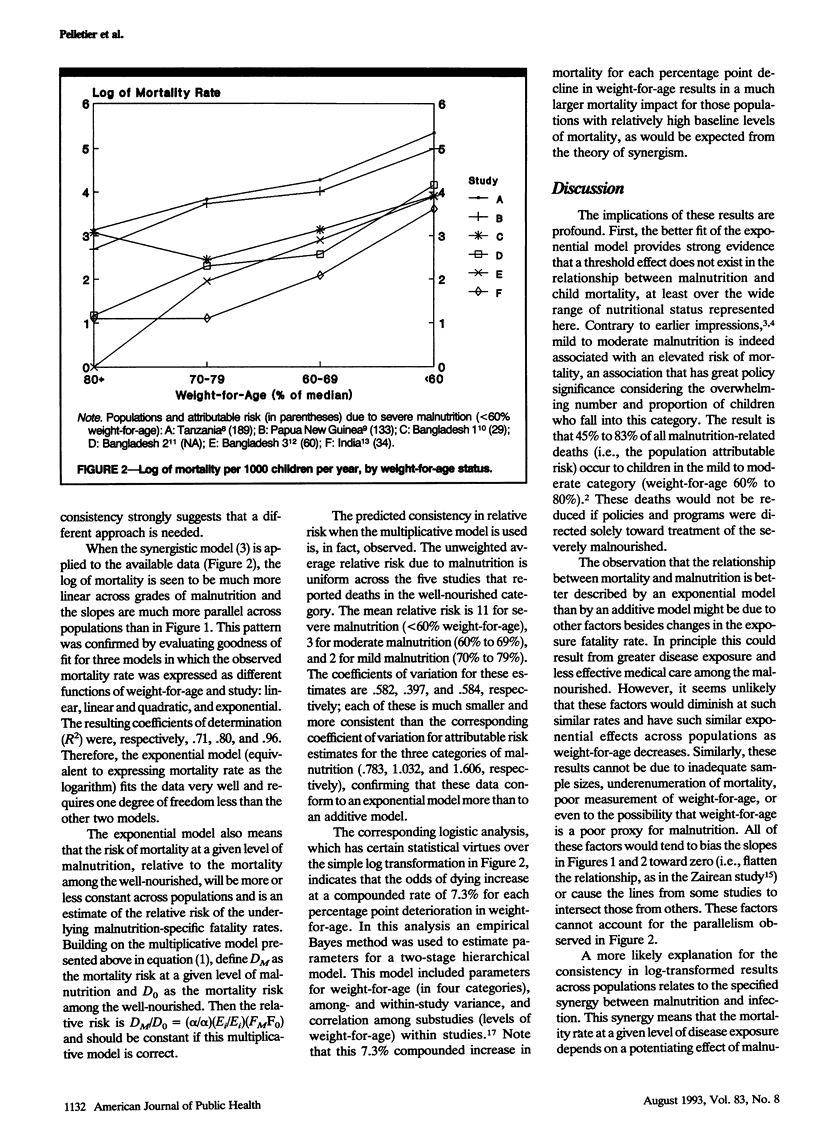Abstract
OBJECTIVES. Despite broad agreement that severe malnutrition contributes to child mortality in developing countries and that malnutrition has a physiologically synergistic relationship with morbidity, evidence of an epidemiologic synergism has been lacking. Also, the literature provides conflicting evidence concerning the existence of elevated mortality among children with mild to moderate malnutrition. A review of published population-based studies of anthropometry-mortality relationships was undertaken to clarify these relationships. METHODS. Six studies with the relevant data were reanalyzed to test for synergism and elevated mortality in mild to moderate malnutrition. RESULTS. The results demonstrate that mortality increases exponentially with declining weight for age. This effect is consistent across studies and there is no apparent threshold effect on mortality. The primary difference across studies is in baseline levels of mortality, which determine the quantitative impact of malnutrition on mortality in a population. CONCLUSIONS. These results indicate that mild to moderate malnutrition is associated with elevated mortality and that there is an epidemiologic synergism between malnutrition and morbidity. This previously undemonstrated finding has significant implications for child survival policies and research.
Full text
PDF



Selected References
These references are in PubMed. This may not be the complete list of references from this article.
- Aukett M. A., Parks Y. A., Scott P. H., Wharton B. A. Treatment with iron increases weight gain and psychomotor development. Arch Dis Child. 1986 Sep;61(9):849–857. doi: 10.1136/adc.61.9.849. [DOI] [PMC free article] [PubMed] [Google Scholar]
- Bairagi R., Chowdhury M. K., Kim Y. J., Curlin G. T. Alternative anthropometric indicators of mortality. Am J Clin Nutr. 1985 Aug;42(2):296–306. doi: 10.1093/ajcn/42.2.296. [DOI] [PubMed] [Google Scholar]
- Bairagi R. On validity of some anthropometric indicators as predictors of mortality. Am J Clin Nutr. 1981 Nov;34(11):2592–2594. doi: 10.1093/ajcn/34.11.2592. [DOI] [PubMed] [Google Scholar]
- Black R. E., Brown K. H., Becker S. Malnutrition is a determining factor in diarrheal duration, but not incidence, among young children in a longitudinal study in rural Bangladesh. Am J Clin Nutr. 1984 Jan;39(1):87–94. doi: 10.1093/ajcn/39.1.87. [DOI] [PubMed] [Google Scholar]
- Chandra R. K. 1990 McCollum Award lecture. Nutrition and immunity: lessons from the past and new insights into the future. Am J Clin Nutr. 1991 May;53(5):1087–1101. doi: 10.1093/ajcn/53.5.1087. [DOI] [PubMed] [Google Scholar]
- Chen L. C., Chowdhury A., Huffman S. L. Anthropometric assessment of energy-protein malnutrition and subsequent risk of mortality among preschool aged children. Am J Clin Nutr. 1980 Aug;33(8):1836–1845. doi: 10.1093/ajcn/33.8.1836. [DOI] [PubMed] [Google Scholar]
- Chwang L. C., Soemantri A. G., Pollitt E. Iron supplementation and physical growth of rural Indonesian children. Am J Clin Nutr. 1988 Mar;47(3):496–501. doi: 10.1093/ajcn/47.3.496. [DOI] [PubMed] [Google Scholar]
- Golden M. H., Golden B. E. Effect of zinc supplementation on the dietary intake, rate of weight gain, and energy cost of tissue deposition in children recovering from severe malnutrition. Am J Clin Nutr. 1981 May;34(5):900–908. doi: 10.1093/ajcn/34.5.900. [DOI] [PubMed] [Google Scholar]
- Hambidge K. M., Hambidge C., Jacobs M., Baum J. D. Low levels of zinc in hair, anorexia, poor growth, and hypogeusia in children. Pediatr Res. 1972 Dec;6(12):868–874. doi: 10.1203/00006450-197212000-00003. [DOI] [PubMed] [Google Scholar]
- Kielmann A. A., McCord C. Weight-for-age as an index of risk of death in children. Lancet. 1978 Jun 10;1(8076):1247–1250. doi: 10.1016/s0140-6736(78)92478-9. [DOI] [PubMed] [Google Scholar]
- Kielmann A. A., Taylor C. E., DeSweemer C., Uberoi I. S., Takulia H. S., Masih N., Vohra S. The Narangwal experiment on interactions of nutrition and infections : II. Morbidity and mortality effects. Indian J Med Res. 1978 Dec;68 (Suppl):21–41. [PubMed] [Google Scholar]
- Mosley W. H. Anthropometry as a screening survey. Am J Clin Nutr. 1981 Nov;34(11):2594–2599. doi: 10.1093/ajcn/34.11.2594. [DOI] [PubMed] [Google Scholar]
- Tarwotjo I., Katz J., West K. P., Jr, Tielsch J. M., Sommer A. Xerophthalmia and growth in preschool Indonesian children. Am J Clin Nutr. 1992 Jun;55(6):1142–1146. doi: 10.1093/ajcn/55.6.1142. [DOI] [PubMed] [Google Scholar]
- Trowbridge F. L., Sommer A. Nutritional anthropometry and mortality risk. Am J Clin Nutr. 1981 Nov;34(11):2591–2592. doi: 10.1093/ajcn/34.11.2591. [DOI] [PubMed] [Google Scholar]
- West K. P., Jr, Djunaedi E., Pandji A., Kusdiono, Tarwotjo I., Sommer A. Vitamin A supplementation and growth: a randomized community trial. Am J Clin Nutr. 1988 Nov;48(5):1257–1264. doi: 10.1093/ajcn/48.5.1257. [DOI] [PubMed] [Google Scholar]


